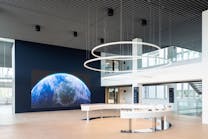Bluetooth charts SSL gains in Osram and Xicato connected LED projects
Denmark office
Osram has announced a connected lighting project in a Kolding, Denmark office building featuring the company’s newly acquired and developed Bluetooth Mesh technology. Xicato has announced a deployment of its Bluetooth-enabled LED light engines in a hotel project completed at the New York JFK airport in the original TWA Flight Center. Both projects show momentum for Bluetooth Mesh as a preferred connectivity option for solid-state lighting (SSL) projects.
We have covered the slow move by Osram into the Bluetooth camp going back more than six months. The company partnered with Bluetooth-technology OEM Silvair to add the wireless option into its portfolio, which from a wireless perspective had been Zigbee based. Meanwhile, the company also transitioned to a new cloud-capable, mobile-device-centric control technology called HubSense, apparently moving away from the Lightelligence Internet of Things (IoT) brand. In reality, Lightelligence was more brand than technology so the HubSense move doesn’t change much.
We covered the initial Bluetooth-based HubSense deployment by Osram back in December 2019, but that project was internal at the Osram headquarters. Now the company has completed a project at a third-party location in the Kolding office building.
The Kolding project was commissioned using an app on a tablet. The HubSense technology can recognize and identify the luminaires and allow assignment to lighting zones and control profiles easily with the app.
TWA Flight Center
Moving to the Xicato project, the new TWA Flight Center hotel is truly an iconic location. TWA was once the trendsetter among airlines and the flight center sports a 1960s mod style where passengers once walked red-carpeted passages to catch flights all over the world. The conversion of the flight center to a hotel reimagined historically-recognized elements of the architecture and the omnipresent red carpet.
To supply the project, Spectrum Lighting developed custom luminaires that resemble the original eyeball, cylinder, and spotlight fixtures that were present in the space. Xicato light engines are used in the fixtures, ensuring uniformity in both chromaticity and light output.
While there were power wires run to the luminaire sites, the renovation to hotel did not have the luxury of disturbing the walls of the historically-listed site. Control of the SSL would require wireless capability. And Xicato has supported Bluetooth Mesh in its modular products for some time now.
“The TWA Hotel project is the perfect example of installations in older construction where we’re not able to run wired connectivity to our light sources but want remote management,” said Chris Roemlien, president of Spectrum Lighting. “Xicato’s Bluetooth solutions were easy to install and delivered a clean look, without any wires, and allowed us to give the hotel remote control of the fixtures.”
Indeed, Xicato has broadened its focus to have a decided emphasis on connected lighting. Back in March, the company announced multiple driver families with integrated Bluetooth Mesh support. The portfolio includes both one- and two-channel designs with the latter capable of tunable lighting applications. The drivers enable third-party luminaires to be combined with Xicato-based luminaires in large projects.
For up-to-the-minute LED and SSL updates, why not follow us on Twitter? You’ll find curated content and commentary, as well as information on industry events, webcasts, and surveys on our LinkedIn Company Page and our Facebook page.

Maury Wright | Editor in Chief
Maury Wright is an electronics engineer turned technology journalist, who has focused specifically on the LED & Lighting industry for the past decade. Wright first wrote for LEDs Magazine as a contractor in 2010, and took over as Editor-in-Chief in 2012. He has broad experience in technology areas ranging from microprocessors to digital media to wireless networks that he gained over 30 years in the trade press. Wright has experience running global editorial operations, such as during his tenure as worldwide editorial director of EDN Magazine, and has been instrumental in launching publication websites going back to the earliest days of the Internet. Wright has won numerous industry awards, including multiple ASBPE national awards for B2B journalism excellence, and has received finalist recognition for LEDs Magazine in the FOLIO Eddie Awards. He received a BS in electrical engineering from Auburn University.






